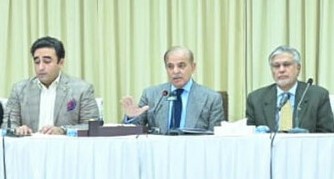In light of Pakistan’s pressing need to secure $10 billion in foreign loans for the remainder of the current fiscal year to avoid default, the International Monetary Fund (IMF) has asked Islamabad for more information about the budget and other matters before starting virtual negotiations.
One government official stated that “without backing and revival of the stalled IMF program,” it would be impossible to raise the $8 to $10 billion in external financing needed to manage the current account deficit and the remaining loan repayment obligations. However, when contacted, a senior member of the Finance Division stated that the IMF had requested more information and that they were waiting for the IMF’s response in the Finance Ministry.
In the meantime, to satisfy the IMF requirement, the government is ready to present its proposal to raise gas prices and make adjustments to the existing slabs before the upcoming meeting of the federal cabinet.
Pakistan previously disclosed the general scope of the tasks to be completed for the upcoming 9th review under the $7 billion Extended Fund Facility (EFF). More information about the budgetary situation has now been requested by the IMF and will be provided to the international lender shortly.
On the other hand, Pakistan now faces a much greater short-term challenge because Islamabad must secure new loans totaling $10 billion in the next five months (Feb.-Jun.) to avoid default. In light of this, the government requested the IMF to revive the program that has been inactive since last November by sending them an SOS (Save Our Soul) letter. Since then, the nation has been sliding toward total economic collapse.
Despite the policy-induced contraction in the current account deficit during the first half of FY23, the State Bank of Pakistan (SBP) acknowledged in its most recent monetary policy that short-term difficulties for the external sector have increased.
The sources cited the SBP’s data as saying that “the fresh loans requirements of $8 to $10 billion cannot be managed without blessings of the revival of the IMF program.”.
Official data indicates that Pakistan had a $23 billion debt repayment obligation for the current fiscal year 2022–2023; of that amount, $15 billion had already been repaid in the form of servicing external debt. The government paid back $9 billion of the $15 billion in debt payments while securing a rollover of $6 billion in the fiscal year’s first half.
The current fiscal year’s second half (Jan-June) has an $8 billion remaining repayment requirement. In March 2023, the bilateral creditor promised to give the government a rollover of $3 billion. The official stated, “On repayment of external debt, there is the exposure of $5 billion which has remained unfulfilled, increasing exposure and risk for the country.”.
The government will have to come up with an additional $5 billion in the upcoming months to cover the projected $8 to $9 billion Current Account Deficit (CAD). The CAD was $3.7 billion in the first half of the current fiscal year (July-Dec), and it is anticipated to increase by another $5 billion in the second half (Jan-June).
According to official sources, the projections have not yet been met, and Islamabad needs an additional $10 billion in new loans to cover its CAD and remaining external debt servicing obligations.
The conclusion of the 9th review will enhance the outlook for the external sector, claims SBP’s presentation. “.
Amid worries about a global recession, it was added that the outlook for the economy remains dim. However, this offers a temporary respite in commodity prices worldwide and allows central banks to scale back their draconian tightening.
These extra $8 to $10 billion cannot be acquired without the revival of the IMF program. Therefore, the government is trying everything to restart the Stalled IMF program. The government has discussed the general framework of the upcoming negotiations and is awaiting the IMF’s response before scheduling the next round of talks.






